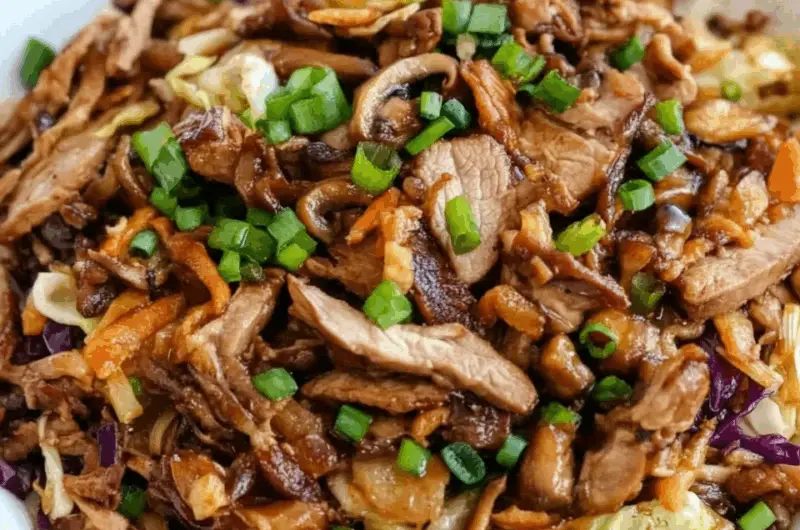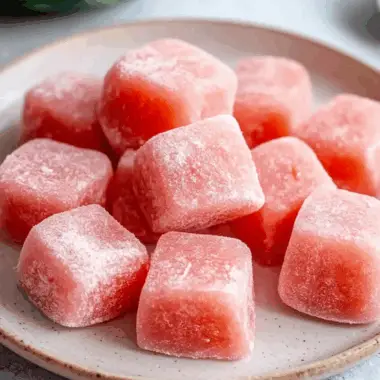A Blend of Traditional Chinese Flavors
At the heart of Moo Shu Pork is the combination of classic Chinese ingredients and techniques. The marinade for the pork, made with hoisin sauce, soy sauce, rice vinegar, and sesame oil, sets the foundation for the dish’s depth of flavor. Hoisin sauce, often referred to as Chinese barbecue sauce, adds a rich, sweet, and savory taste to the pork. Soy sauce provides the necessary saltiness and umami, while rice vinegar adds a touch of acidity that balances the richness of the other ingredients. Sesame oil, with its toasted nutty flavor, rounds out the marinade and adds a fragrant aroma to the dish.
The vegetables in Moo Shu Pork are just as important as the pork itself. The use of shiitake mushrooms adds an earthy flavor, and the coleslaw or shredded cabbage and carrots provide a crunchy texture that contrasts beautifully with the soft pork and scrambled eggs. The inclusion of green onions adds a refreshing, mild onion flavor that elevates the dish with its crispness and color.
The Magic of Marinating Pork Tenderloin
The use of pork tenderloin in Moo Shu Pork ensures that the dish is both tender and flavorful. Pork tenderloin is a lean cut of meat that, when marinated properly, becomes moist and tender. The marinade, which includes ginger, garlic, and a variety of seasonings, penetrates the pork, infusing it with flavor and making it incredibly juicy. As the pork marinates, it absorbs the flavors of the hoisin sauce, soy sauce, and rice wine, creating a savory base that complements the other ingredients.
Marinating the pork is a simple but crucial step in making Moo Shu Pork. The marinade allows the flavors to meld together, ensuring that every bite of the pork is infused with a balance of sweet, salty, and savory tastes. Allowing the pork to sit in the marinade for at least 30 minutes to an hour ensures that the flavors are fully absorbed, making each strip of pork tender, flavorful, and satisfying.
The Perfect Cooking Technique
Cooking Moo Shu Pork requires a few simple steps but relies on precise timing and technique to achieve the perfect balance of flavors. The first step is to scramble the eggs, which will add richness and texture to the dish. Cooking the eggs separately ensures they stay soft and fluffy, providing a light and airy component that contrasts with the tender pork and crispy vegetables.
Once the eggs are cooked, the next step is to sauté the pork. The marinated pork is quickly cooked in the pan, where it is seared until browned on the outside while remaining juicy on the inside. It’s important not to overcook the pork, as pork tenderloin can become dry if cooked for too long. Cooking the pork in batches helps ensure that it browns evenly and doesn’t overcrowd the pan, which could cause it to steam instead of sear.
Finally, the vegetables are stir-fried in the same pan, allowing them to soften slightly while still retaining their crunch. The cabbage and mushrooms should be cooked just long enough to wilt and tenderize, but not so long that they lose their fresh flavor. The combination of the cooked pork, scrambled eggs, and vegetables creates a harmonious mixture of textures, with the crisp cabbage and mushrooms complementing the tender pork and rich sauce.
The Sauce: Sweet, Savory, and Spicy
The sauce in Moo Shu Pork is a key component that ties all the flavors together. Made with hoisin sauce, soy sauce, sriracha, and maple syrup, the sauce is both sweet and savory, with just the right amount of heat. Hoisin sauce provides the sweetness and depth, while soy sauce and sriracha add saltiness and heat, respectively. Maple syrup adds a natural sweetness that balances the spiciness of the sriracha, creating a perfect glaze for the pork and vegetables.
The rice wine vinegar in the sauce adds acidity, cutting through the richness of the hoisin and soy sauce and providing a fresh, tangy note. Gochujang, a fermented Korean chili paste, brings an additional layer of heat and complexity, making the sauce both flavorful and balanced. Together, these ingredients create a sticky, savory-sweet sauce that coats the pork and vegetables, ensuring that each bite is packed with flavor.
Serving Moo Shu Pork: Customizing the Dish
Moo Shu Pork is traditionally served with flour tortillas or Chinese pancakes, allowing the dish to be wrapped and eaten with your hands. The soft tortillas or pancakes provide a perfect vessel for the flavorful pork, eggs, and vegetables, making it a fun and interactive dish. If you want to make the meal even more authentic, you can opt for Chinese pancakes, which are slightly thicker and have a more chewy texture compared to flour tortillas. However, tortillas are a great alternative and make the dish more accessible for those who may not have Chinese pancakes on hand.
In addition to serving Moo Shu Pork with tortillas or pancakes, it pairs beautifully with a side of steamed rice. The rice helps balance the richness of the pork and sauce, soaking up the extra flavors and making for a more filling meal. You can also serve Moo Shu Pork with a side of Asian slaw for a fresh, crunchy contrast or gyoza for a complete Asian-inspired meal.
Customizing Moo Shu Pork
One of the great things about Moo Shu Pork is how easily customizable it is. While this recipe calls for pork tenderloin, you can substitute it with chicken breast, beef, or tofu for a plant-based option. The vegetables can also be adjusted to suit your preferences. If you prefer a heartier dish, you can add bell peppers, carrots, or water chestnuts to the mix for added texture and flavor. You can also adjust the heat level of the sauce by adding more or less sriracha or gochujang, depending on your spice tolerance.
For a more vegan-friendly version, substitute the eggs with scrambled tofu or chickpea flour for a similar texture without the use of animal products. The sauce can also be made without maple syrup for a sugar-free version or replaced with coconut nectar or another natural sweetener.
Nutritional Benefits of Moo Shu Pork
Moo Shu Pork is not only delicious but also packed with nutrients. The pork tenderloin provides a high-quality source of protein, which is essential for muscle growth and repair. The cabbage and mushrooms add a good dose of fiber, vitamins, and minerals, including vitamin C, vitamin K, and iron. The addition of green onions adds a mild flavor and offers a small amount of vitamin A and folate.
Despite being a rich dish, Moo Shu Pork can be made lighter by using low-sodium soy sauce and reduced sugar options for the hoisin and maple syrup, which reduces the overall sodium and sugar content. Additionally, the dish is relatively low in carbohydrates when served with just the pancakes or tortillas, making it suitable for those following lower-carb diets.
Conclusion
Moo Shu Pork is a delicious, flavorful, and easy-to-make dish that brings the bold tastes of Chinese cuisine to your kitchen. With its tender pork, crispy vegetables, and savory sauce, it’s the perfect alternative to takeout and a great option for a weeknight dinner. Whether served with tortillas, Chinese pancakes, or steamed rice, Moo Shu Pork offers a balanced meal that is both satisfying and customizable. This dish’s combination of sweet, spicy, and savory flavors makes it an instant family favorite, and the option to adjust the ingredients to suit different tastes ensures it can be enjoyed by everyone. Whether you’re cooking for yourself or a group, Moo Shu Pork is a dish that promises a delightful and flavorful dining experience.








